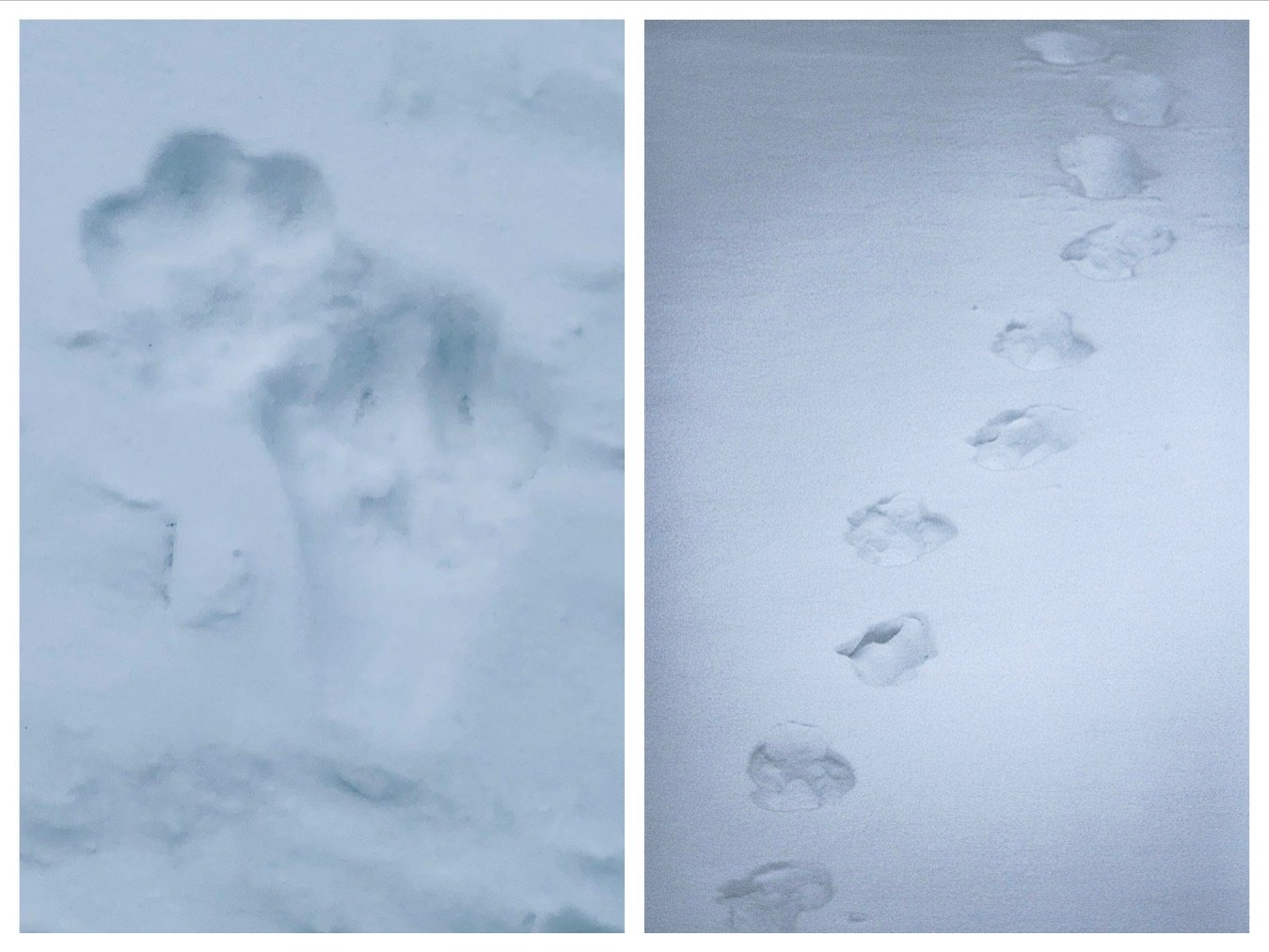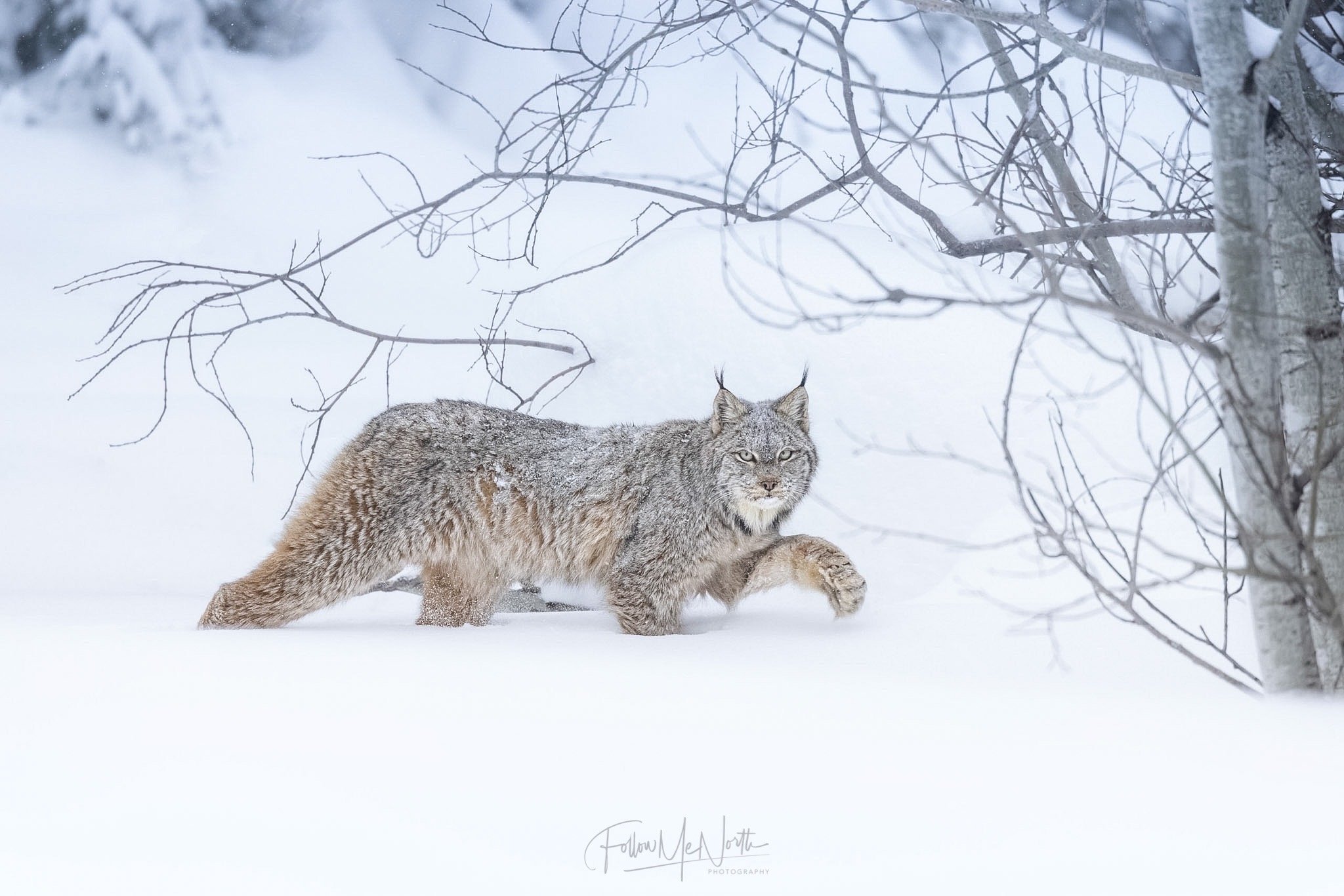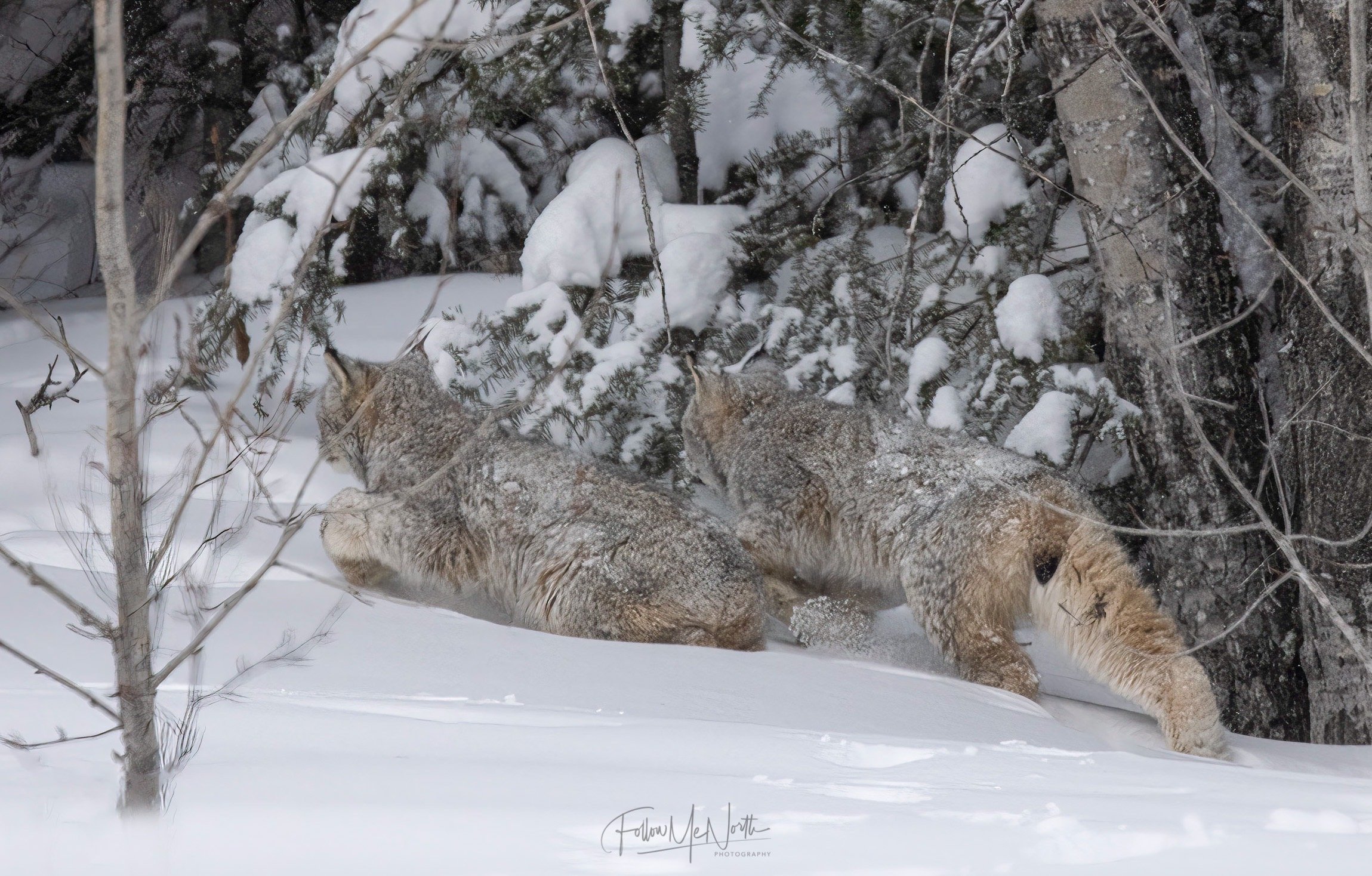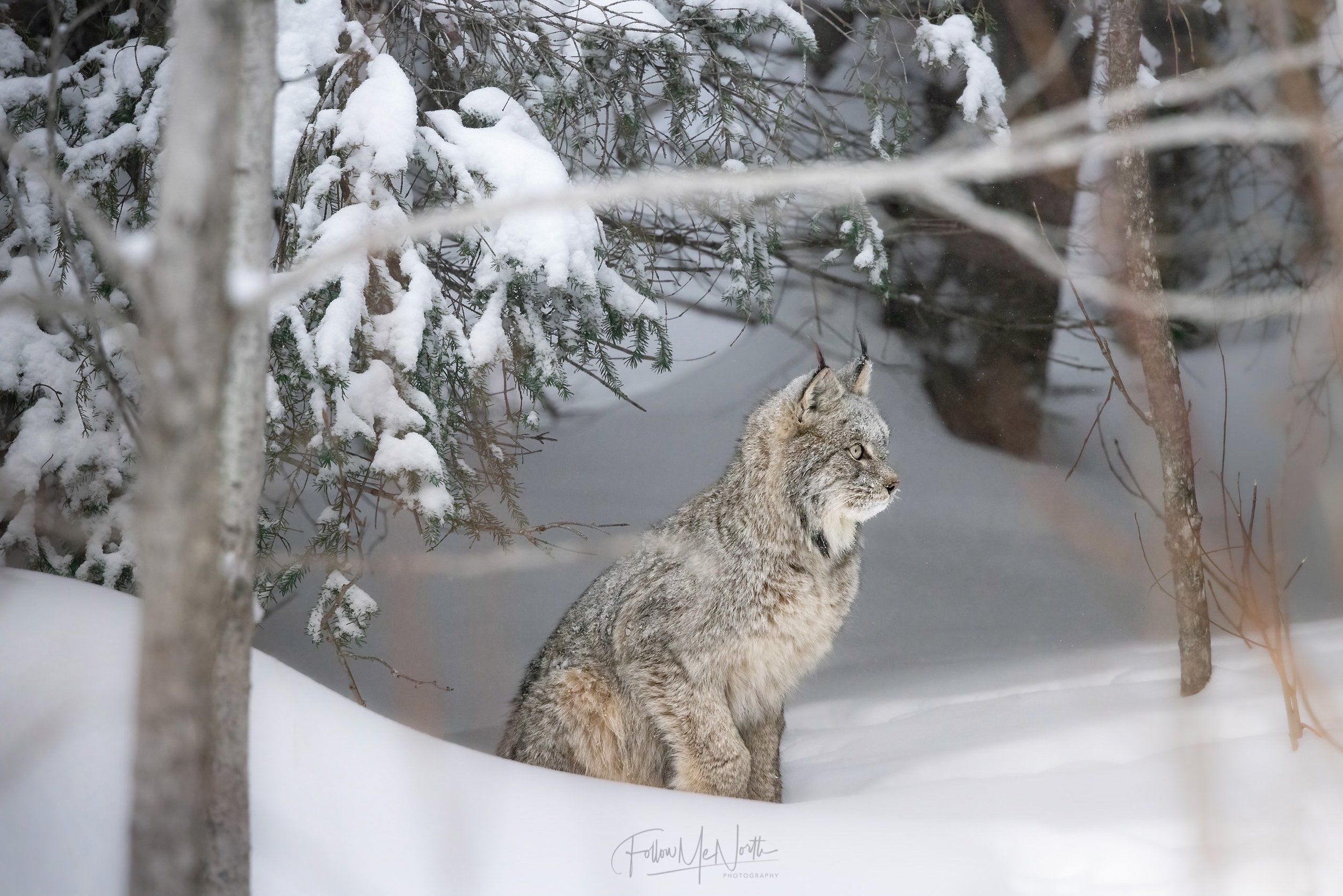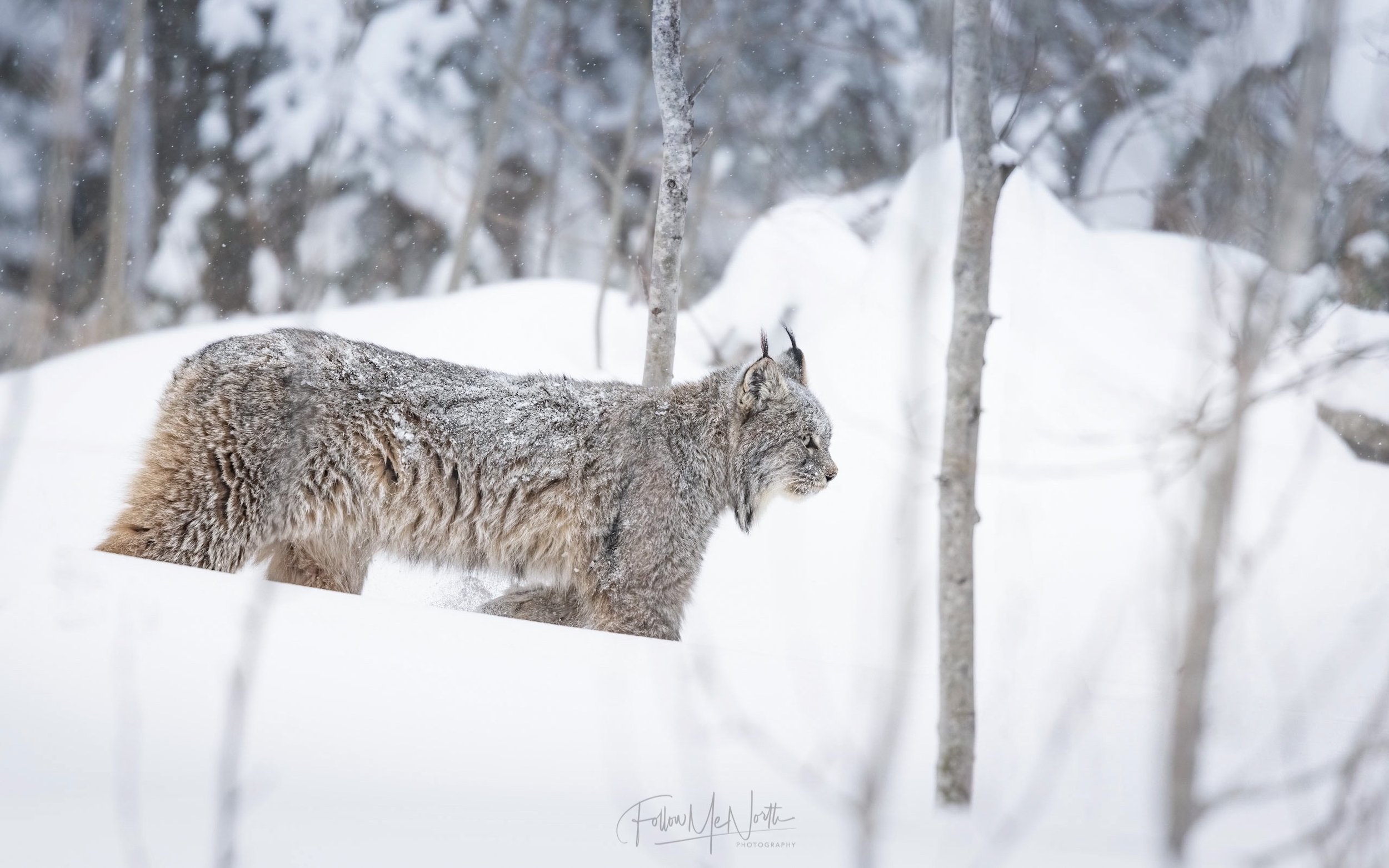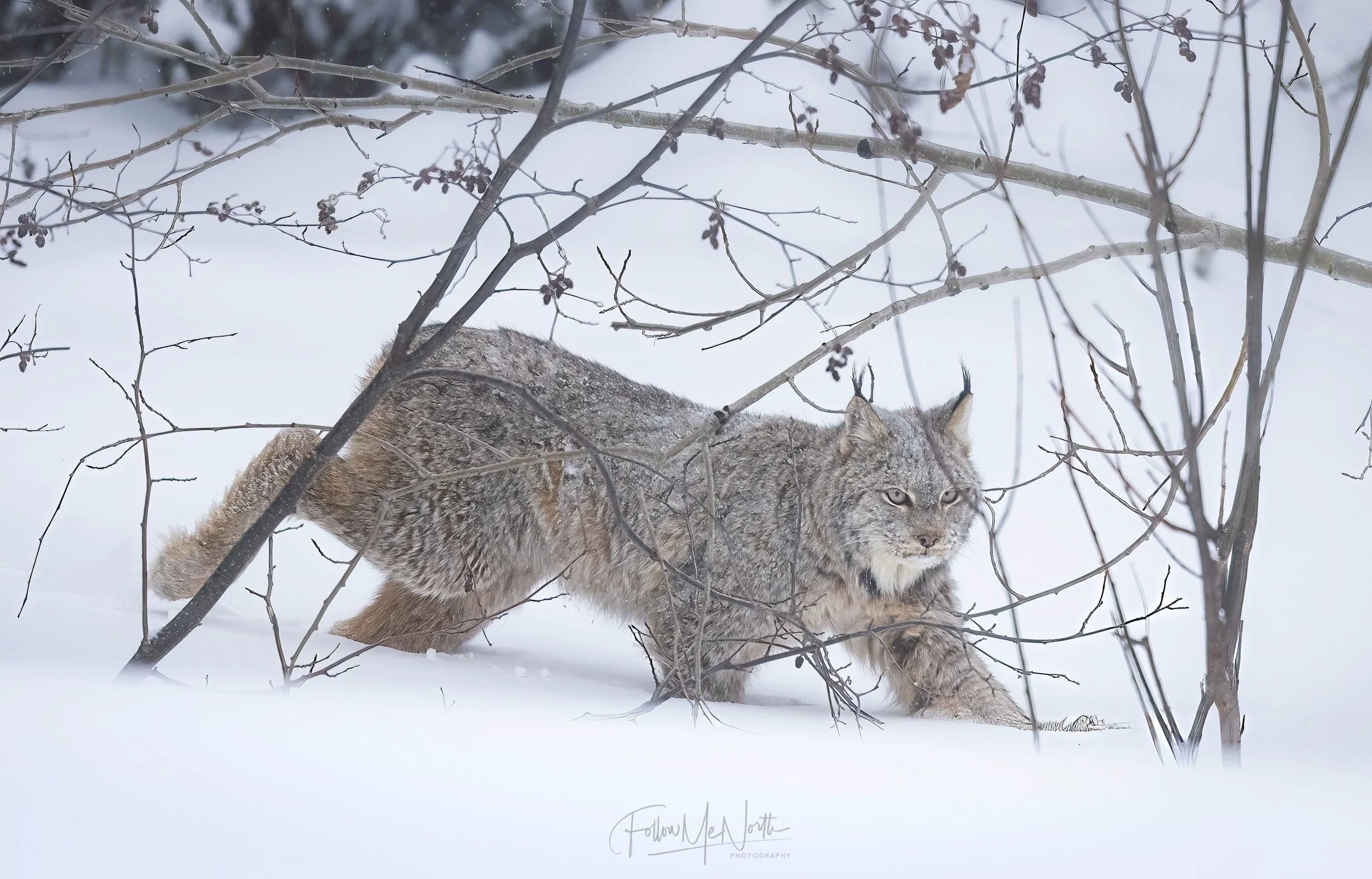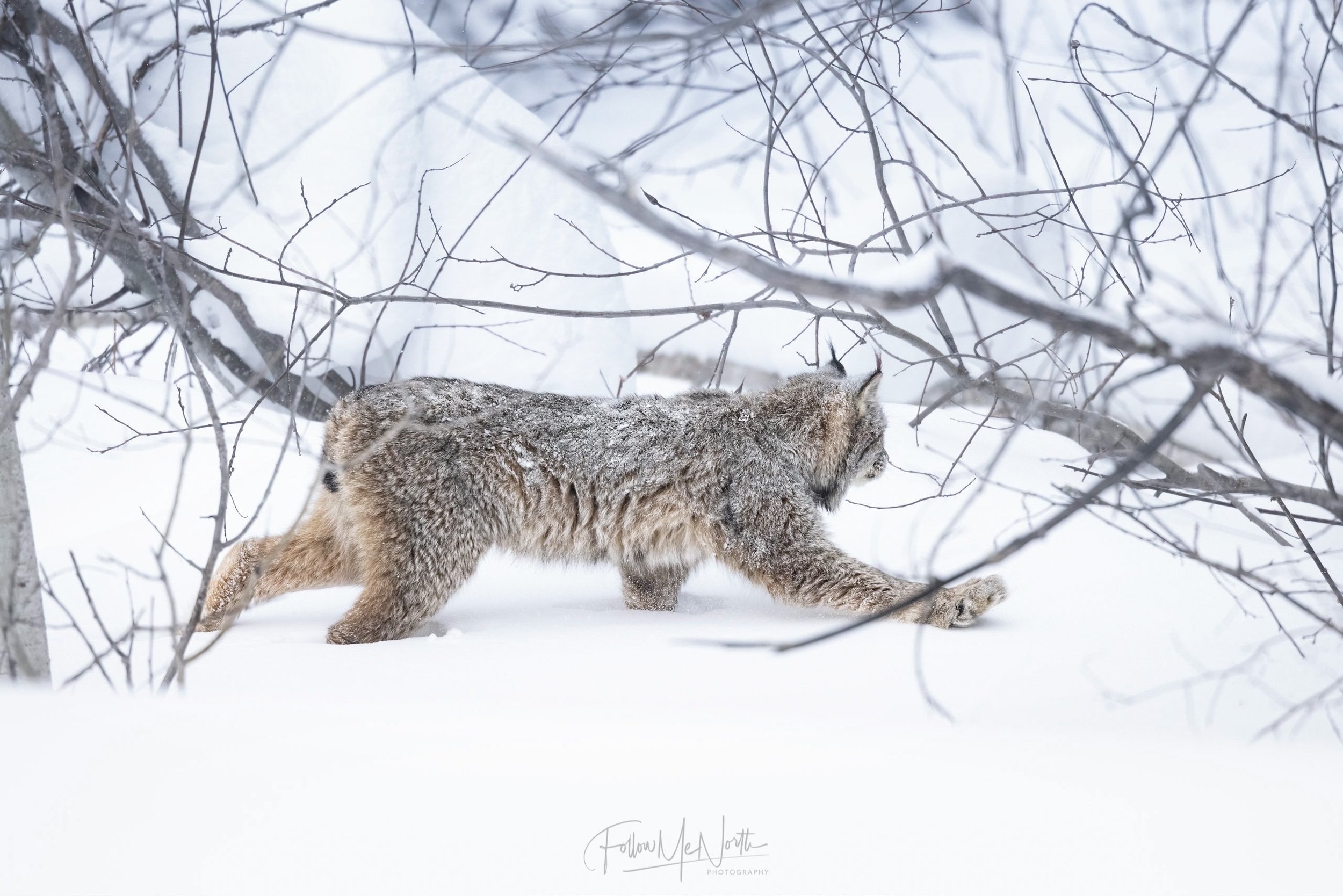Part 1: Pursuing the ‘Shadow of the Forest’
Our spontaneous nature beckons us to venture out into unchartered areas of the wilderness and we’re often rewarded for doing so.
A favourite example of our luck happened last summer, when we only had 36 hours to explore Algonquin’s backcountry between photography workshops and encountered 24 moose - grazing, swimming and not the least bit camera shy.
Our latest, ambitious adventure found us with only 36 hours to spare. With Muskoka covered in a sheet of ice and persistent rain in the forecast, we opted to journey six hours from home for the chance of scoring a unique wildlife opportunity in fresh, powdered snow. We braced ourselves for harsh weather and were met with brutal road conditions, facing frigid temperatures and two rounds of snow squalls. The purpose of our 1600 km roundtrip was to catch a glimpse of the ever-elusive Canada lynx, otherwise known as the “Shadow of the Forest.”
In 2019, we encountered our first “wild” lynx on Christmas Day in Algonquin Park and have been itching for more face time ever since.
On Tuesday morning, we scrambled to pack the car before 6 a.m. and started driving North. Without an official agenda or destination, we scanned the snow drifts of Ontario’s lesser-known back roads in search of fresh lynx prints and bedded-down areas.
After a fresh snowfall, we routinely pack up our snowshoes for wildlife tracking practice. Winter presents a distinct advantage as animals that are hard-to-find are suddenly visible, or at least can be proven to exist!
The amount of snow we endured on this particular road trip surprised us and made scouting difficult as the snow banks along the roads were higher than our vehicles line of sight. With swanned necks and wide-open peepers, we scoured the landscape for any and all signs along the forests edge.
With snow falling heavily throughout the day, any prints we were finding were difficult to distinguish between new and old. Odds were against us, and many roads weren’t plowed enough for our vehicle to tackle. Day one turned out to be a bust and we retired after sunset to get a fresh start on Wednesday morning. On a side note, apparently we were excited, because by the time we tired of driving, and reached a hotel, we realized someone forgot their luggage. Hint: It wasn’t Jesse.
After a good nights sleep, we ventured even further north at the crack of dawn. The wind was intense, blowing our vehicle all over the road. Just when we were going to make the call to journey home we saw four silhouetted creatures crossing the road, seemingly in slow motion, a few hundred feet in front of us.
As we approached, we confirmed our dizziest daydream had come true - momma lynx and four kits. We crossed our fingers and toes that they wouldn’t disappear into the forest, not to be seen again, by the time our vehicle made it to them.
As we exited the car, we could hear three distinct “meowing” vocalizations from within the thick bush. Time stopped. This was, hands-down, the cutest, most thrilling sound we’ve ever heard. Mom reassured her kits and they slowly emerged from the forest and stalked the tree line within view, weaving in and out of sight - and quickly.
Admittedly, this was one of the more challenging photo opportunities of our careers. Just when we settled on a composition, the lynxes would dodge out of view or into dim light. They proved to be utterly impossible to photograph as a group, dispersing in different directions only to reconvene when they were behind layers of branches.
We had a small window of time to race on top of a snow bank to witness moms interactions with her kits, but just when we got into position - they vanished once again. We inspected our surroundings for prints and indicators of their direction. Had they been staying in this area for long?
Suddenly, out of the depths of the shadowed forest a lynx appeared and sat down with its eyes fixated on something out of sight. To our surprise, the lynx lowered its body to the ground and in one bound - leap up at a frantic snowshoe hare, who darted past us, running for dear life as a second lynx chased it out from underneath a low, slopped tree! This happened in the blink of an eye and we’re not convinced we would have captured this interaction masterfully, even if we had known the hare was in hiding.
What an experience! We have dreamed of this moment for years, searching high and low for fresh signs of this elusive mammal - and here they were, hunting in front of our lenses!
After hearing an extensive chase in the deep woods, we discovered solo hare prints hopping back towards the road. We concluded the snowshoe hare lived another day, after leaving the lynxes in a fit of a confusion from its Houdini-like trickery.
After the lynxes disappeared into the forest indefinitely, we were left smiling in the middle of a windy, barren road - freezing and satisfied.
Useful Lynx Facts
Lynx favour old growth boreal forests with a dense undercover of thickets and windfalls. However, this carnivore, will populate other types of habitat as long as they contain minimal forest cover and adequate numbers of prey, in particular snowshoe hares. Because hare populations increase in forests that are growing back after disruption by wildfires or logging operations, these regenerating forest ecosystems are often able to support denser populations of lynxes.
The size of lynx home range varies based on the number of snowshoe hares, available cover and season. When there are fewer hares, each lynx needs a larger area on which to hunt. In Summer, home ranges are larger than in Winter. In Alberta, lynx tracked in Winter had home ranges varying from 15 to 47 km. On Cape Breton Island, a study measured home ranges of 12 to 19 km in Winter and 27 to 32 km in Summer. In Canada, scientists have measured daily travelling distances for lynxes ranging from less than a kilometre to 19 km.
More than 75 percent of the lynx’s diet in Winter is snowshoe hares, and when they are abundant a lynx may kill one hare every one or two days. In Summer, the lynx’s diet is more varied. But even in Summer hares remain the main prey, supplemented by grouse; voles, mice, squirrels and foxes. A hungry lynx will devour an entire hare in one meal. It may also hide partially eaten prey to finish later. When it is available, lynxes will also supplement their diet with carrion, or dead flesh, from domestic livestock or big game animals, such as deer.
Lynxes often hunt at night. They watch and listen for prey, but they do not seem to track it by smell. Like all members of the cat family, they move silently. Although excellent climbers, they are seldom found in trees. Because they cannot run fast, except over short distances, they stalk or ambush their prey at close range. A common strategy is to lie in wait beside the well-used trails, or runways, of the snowshoe hare. Success usually depends on whether the lynx manages to capture the hare at one bound—about 6.5m or four hops for the hare.
Male lynxes hunt alone, except briefly during the mating season. By Autumn, females travel with their kittens, the young learning to hunt, and the family group may stay together until the breeding season, in late February or March. Family groups cooperate to increase their hunting success. The mother and young often travel in single file through habitat where hares are scarce, but will travel abreast when hunting in habitat where hares are plentiful. A hare flushed, or forced out of its hiding place, by one lynx may be caught by another. (Which was absolutely the case with our Lynx sighting)!
Mating occurs during February or March each year, and the young (usually four) are born in April and May, 60 to 65 days later. Although the lynx seldom uses an underground den, young may be born under brush piles or uprooted trees, or in hollow logs, which provide shelter from rain and cold. Female kits may breed for the first time as they approach one year of age, but this depends on the abundance and availability of snowshoe hares and the physical and nutritional condition of the lynx.
Check out the Canadian Wildlife Federation for more fun facts!
Resources
Banfield, A.W.F. 1974. The mammals of Canada. University of Toronto Press, Toronto.
Brand, C.L., and L.B. Keith. 1979. Lynx demography during a snowshoe hare decline in Alberta. Journal of Wildlife Management 43:827–849.
Elton, C., and M. Nicholson. 1942. The ten-year cycle in numbers of the lynx in Canada. Journal of Animal Ecology 11:215–244.
MacLulich, D.A. 1937. Fluctuations in the numbers of the varying hare (Lepus americanus). University of Toronto Studies Biological Series 43. University of Toronto Press, Toronto.
Parker, G.R., J.W. Maxwell, L.D. Morton, and G.E.J. Smith. 1983. The ecology of the lynx on Cape Breton Island. Canadian Journal of Zoology 61(4):770–786.
Quinn, W.S., and G.R. Parker. 1987. Lynx. In M. Novak, J.A. Baker, M.E. Obbard, and B. Malloch, editors. Wild furbearer management and conservation in North America. Ontario Ministry of Natural Resources, Toronto.
Location: PO Box 45 Baysville PO Baysville, Ontario Canada P0B 1A0
Phone: (705)-242-6621
Instagram: https://www.instagram.com/followmenorth/
Website: https://www.followmenorth.com/

